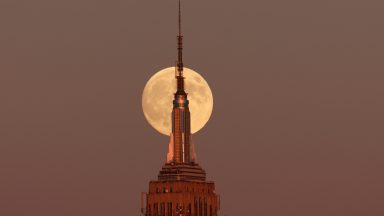Stargazers are in for a treat! The Hunter's Supermoon, known as the largest supermoon of the year, recently graced the skies, captivating everyone who took the time to look up. On October 17, 2024, it reached its full phase, appearing larger and brighter than previous supermoons this year. Not only was the moon a stunning sight, but it also coincided with the dazzling Comet Tsuchinshan-ATLAS, making the night even more magical.
Supermoons occur when the moon is closest to Earth in its orbit, making it appear significantly larger than usual. The Hunter's Moon is particularly special, as it marks a time traditionally associated with the onset of hunting season. This year, it was visible at its peak illumination at 7:26 AM ET, a perfect time for early risers to catch a glimpse of this breathtaking natural phenomenon.
For those who missed this celestial event, there’s no need to worry! The next supermoon will rise on November 15, 2024, marking the last in this year's series. Whether you're an astronomy enthusiast or just someone who enjoys the beauty of the night sky, the Hunter's Moon is an experience not to be missed.

The Hunter's Moon, a name steeped in history, signifies the time of year when hunters would prepare for the cold months ahead. The Old Farmer's Almanac notes that this full moon follows the Harvest Moon and is linked to various cultural traditions, showcasing the rich tapestry of human connection to the lunar cycles.
To fully appreciate the Hunter's Supermoon, consider the best practices for viewing such celestial wonders. Timing is crucial, as the moon appears most stunning during moonrise or moonset near the horizon. Finding a location away from city lights can enhance your experience, providing a clearer view of this luminous orb in the night sky.
For those wondering how to catch the next supermoon, remember: no special equipment is needed! Simply your eyes will suffice, but binoculars or a telescope can offer a more detailed perspective. Framing the moon against landmarks can create a stunning visual illusion, making it appear even larger than life.
Why Is the Supermoon Called Hunter’s Moon?
The name "Hunter's Moon" has historical significance, originating from the need for hunters to prepare for the winter months. According to the Old Farmer's Almanac, this full moon signifies the start of the hunting season, a time when animals are easier to spot as they scavenge for food after harvest. The moon's bright light made it easier for hunters to track their prey during the chilly autumn nights.
This full moon is also referred to as the Sanguine or Blood Moon, drawing connections to the color of the leaves changing during fall and the bloodshed associated with traditional hunting practices. The naming of full moons has been a practice for centuries, reflecting the relationship between humans and nature, particularly in agricultural societies.
When Is the Next Supermoon?
If you missed the October spectacle, mark your calendars for November 15, 2024, when the next supermoon will illuminate the night sky. This event will be the final supermoon of the year, offering another chance to witness the beauty of our celestial neighbor.
Planning ahead is key to enjoying this astronomical event. Take note of the moonrise and moonset times in your area, and ensure you have a good vantage point. Whether you’re with family, friends, or simply enjoying a quiet moment alone, the supermoon provides a wonderful opportunity to connect with the universe.
What Is the Best Way to See a Supermoon?
- Timing is key: The supermoon appears most impressive during moonrise or moonset, when it’s near the horizon.
- Escape light pollution: For an enhanced view, consider venturing outside city limits to avoid artificial lighting.
- No special equipment needed: The supermoon is visible to the naked eye, though binoculars or a telescope can offer a more detailed look.
- Frame the view: When the moon is low on the horizon and framed by landmarks, it creates an optical illusion that makes it appear even larger.



